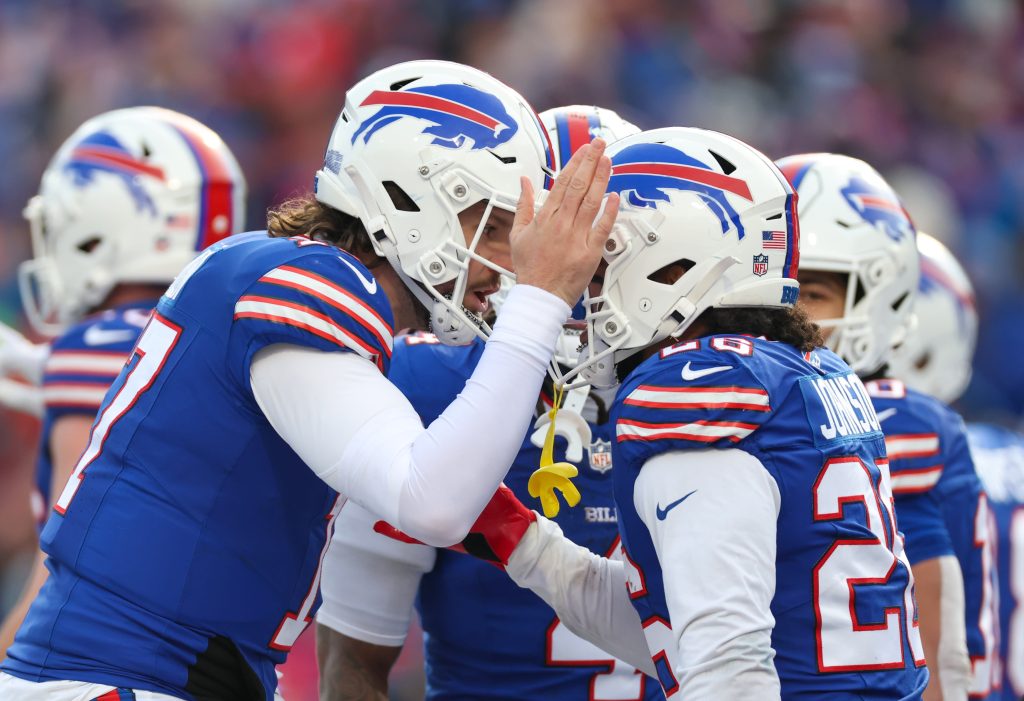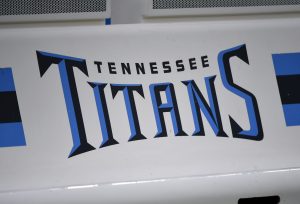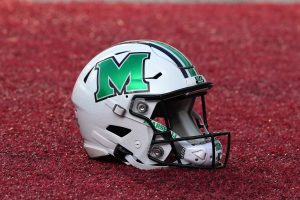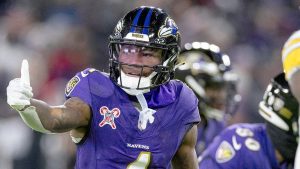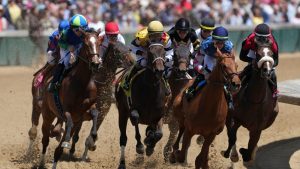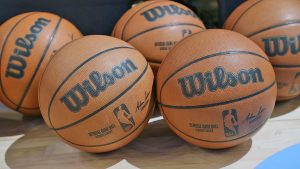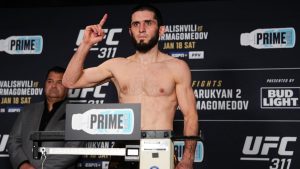Three teams are at least six-point dogs this weekend, which is uncommon for the divisional round. But there’s a path to victory for each — including the Bills at home.
One of the greatest sports weekends of the year is here to get us going in 2025. The NFL divisional round features teams with either a playoff win under their belt (for the first time in two decades for the Commanders) or are coming off a well-earned bye week as the No. 1 seed.
While the divisional round is surely going to feature the league’s best going at it and emptying their respective playbooks, three of the games feature bigger spreads than we commonly get divisional weekend; the Houston Texans are 8.5-point underdogs, while the Commanders are 9-point underdogs and the Rams 6.
For this week’s Football 301 Playbook, I’m going to preview each divisional round matchup — but with the angle of how an upset could happen for the underdogs (plus the Buffalo Bills, who are currently 1-point home dogs to the Baltimore Ravens).
Texans (+ 8.5) at Chiefs
Texans: Lean on ravenous pass rush and defensive stars
It’s a conundrum for Andy Reid and offensive line coach Andy Heck this weekend.
First option: keep Joe Thuney at left tackle and Mike Caliendo — owner of more career receiving yards (5) than career starts (3) — at left guard. That’s what the Chiefs rolled with in Week 16 vs. the Texans (Thuney allowed seven pressures on one-on-one pass blocks that game and Caliendo allowed three). Thuney is an excellent guard and has been more than serviceable at left tackle in his career. There’s also the argument that Caliendo could be sandwiched between two plus-plus starters in Thuney and center Creed Humphrey, allowing Caliendo to do his best Thuney impression. But it puts the inexperienced Caliendo on the field against Denico Autry and the Texans’ devastating pass rush twists with Will Anderson Jr. and/or Danielle Hunter blasting open the interior line as penetrators..
The option behind Door No. 2 is D.J. Humphries, a veteran signed midseason as a potential stopgap. He has battled injuries since setting foot (or walking boot) in Kansas City. Humphries’ recent start in Week 18 against Denver was uninspiring to put it nicely (there is a Carson Wentz-sized asterisk with that). But Humphries has plenty of starts under his belt and now has had a couple of more weeks to get himself closer to 100% and further acclimated with the Chiefs’ surroundings. This would also put Thuney back inside, turning the left guard into to an A-level position for the Chiefs and further solidifying the interior against the Texans’ stunts. (I’m telling you, they’re no joke.)
You can see that there is no perfect answer for the Chiefs. That is what gives the Texans a path here.
A ravenous pass rush is the great equalizer in the NFL, and the Texans have that in spades. They’re second in team pressure rate this season with Hunter and Anderson both ranking individually in the top 10. And while this pass rush can do some damage by just rushing four, I would be interested if the Texans decided to lean into a blitz-heavy scheme on early downs as well. Chiefs quarterback Patrick Mahomes has constantly found answers against the blitz in his career. Perhaps the Texans increase the heat that they bring on first and second down as a way to keep third downs as less-than-manageable for the Chiefs.
The Chiefs won the first matchup 27-19 between these two teams, with wide receiver Hollywood Brown making his KC debut. The Texans were missing several players during that tilt. Linebacker/human missile Azeez Al-Shaair was in the middle of his three-week suspension for his hit on Trevor Lawrence, and defensive tackle Foley Fatukasi was out with an ankle injury. Both of their recent returns have a giant impact on the Texans’ defense.
Fatukasi’s impact is in the run game. The Texans love having their defensive linemen fire off the football and get penetration immediately to disrupt the offense. Fatukasi provides bulk in the middle to help clog things up for his speedier (and lighter) teammates. When Fatukasi hasn’t been healthy, his absence is felt. Without Fatukasi on the field on early downs this season, the Texans ranked 20th in early down rushing success rate allowed and 10th in EPA per rush allowed. With Fatukasi on the field, the Texans rank second and first in the same categories.
The Chiefs’ run attack is a barrage of jabs, and while they have some clean answers they can find in the run game (namely on trap runs and other runs featuring pullers), keeping the Chiefs behind the sticks can make this game turn into a one-on-one fight across the board.
On late downs, the Texans have continued to take the fight to offenses with their relentless man coverage. Derek Stingley Jr. has shut down receivers on the offense’s right side, exclusively on the outside. Kamari Lassiter had a strong rookie season opposite Stingley, including an interception and other high-leverage plays against the Chargers during the Texans’ wild-card win while patrolling the offense’s left.
Great 3rd down coverage from Kamari Lassiter. Doesn’t get threatened vertically at all and is able to stay right in Quentin Johnston’s hip on the crosser. pic.twitter.com/87cpNZz0FA
— Nate Tice (@Nate_Tice) January 15, 2025
And on top of it, Lassiter has a great nickname brewing with “The Locksmith,” another point in his favor (just don’t think about it too hard).
The Texans played man coverage in these teams’ first meeting, with the Chiefs unloading their man coverage beaters on every passing down and testing the Texans’ communication. Houston doesn’t try to disguise its man coverage, which has to frustrate offenses as they unsuccessfully test it. The Texans are even good defending slot targets in man coverage despite a rotating cast of characters at the position.
Mahomes has more pass attempts against Cover 1 (man coverage) than any other QB in the NFL this season, while also having the most passing yards, first downs, and ranking in the top four of every efficiency metric that you can look up, as a thrower and runner alike. (Mahomes has been successful on nine of his 11 scrambles against Cover 1 this season).
The Texans either use their free player to participate in the pass rush or, like they did against the Chiefs, use him as a spy. Al-Shaair is the difference-maker for this Texans defense, and while he got banged up in the wild-card round, he practiced this week, albeit in a limited capacity.
Mahomes had no issues picking apart the Texans’ man coverage the first time around, so I’ll be curious if head coach and defensive play-caller DeMeco Ryans uses any changeups to get Mahomes to hesitate and hold onto the ball, giving his pass rush more time to get home. With Al-Shaair out, the Texans experimented with running Cover 2 invert (where the safeties cover the flat and corners cover deep) a little bit, with mixed results.
The other side of the ball essentially comes down to how the Texans’ shaky pass protection holds up against the playoff game plan maestro himself, Steve Spagnuolo. (Look out for plenty of corner blitzes!) Although the Texans’ run game showed life against the Chargers last week, the Chiefs have been stout against the run this season.
Either way, Ryans and defensive coordinator Matt Burke have been dancing with the ones who brought them all season. There’s a path for them to give themselves a real chance against the defending back-to-back champs, and conveniently it’s a pass rush path.
But just remember, if you come at the king with these one-on-one battles, you best not miss.
Commanders (+9) at Lions
Commanders: Crank up the tempo — which they’re already good at — and target the slot
The Lions have suffered injuries, mainly on the defensive side, but have still managed to put together strong performances in the back half of the season. There are still things to pick at for the Commanders, namely keeping their tempo at a high level to hopefully create explosive plays for their offense.
The Commanders under offensive coordinator Kliff Kingsbury have, unsurprisingly, run more no-huddle plays than any other offense in the NFL this season. One of the best aspects of their offense is their ability to get to a (relatively) large menu of plays while using high tempo to get on the ball, catching defenses in bad personnel groupings or unable to get to their more exotic play calls.
The Lions have overwhelmed offenses with their stout front seven on early downs and physical man coverage on late downs, and have continued to rank as one of the league’s better defenses despite facing injury after injury (and now getting players like linebacker Alex Anzalone and corner Ennis Rakestraw Jr. back).
But they actually have a weakness: defending offenses that use an up-tempo attack.
Removing plays inside the two-minute warning of each half, when offenses are generally looking to stay out of huddling and cranking their tempo up, the Lions are one of the worst defenses in the NFL against no-huddle plays, ranking 31st in success rate allowed and 26th in EPA per play, and ranking equally poor against both the run and pass. Going against an offense that will use no-huddle for nearly half of its “normal” plays, this is something the Commanders can keep pressing, or even use the threat of going up-tempo to prevent the Lions from huddling and keeping their calls simplistic for quarterback Jayden Daniels and the offensive line to sort through and attack.
This is what I like to call a “natural” path for the Commanders. They don’t have to change up how they play, just crank up the no-huddle dial a little bit more against the Lions (who had a bye week to prepare for this game, which has to be emphasized). The Commanders don’t have the most explosive offense in the world, ranking more middle of the pack, but they can put together methodical drives and keep moving the chains. Leaning even more into no-huddle can help keep those drives clean for Daniels on early downs.
When Daniels throws, it’s really a game of beating man coverage and blitzes. Daniels has been one of the league’s better QBs against the blitz. His awareness, quick throwing motion and scrambling ability help him find consistent answers. But the Lions have tweaked their man coverage to take away primary options, like shading Justin Jefferson with a safety here …
The Lions defense matched their Nickel personnel (5 DBs) to Base offense (2 WR personnel) only 14 times the whole season before matching 15 times against the Vikings in week 18.
Thought this was a great example of how using light bodies can be weaponized if used the right way. pic.twitter.com/NFf9z2DfUR
— Nate Tice (@Nate_Tice) January 8, 2025
… and they’ve won more battles than they lost, despite allowing explosive passes at a fairly high rate (fifth-worst in the league since Week 11).
The Lions have generally been good in coverage this season. But there are a couple of areas that Daniels can attack when he sees the Lions in man coverage. First, there are his running backs. The Lions are one of the worst defenses this season against RB targets (the Bills had a lot of fun using Ty Johnson against this weakness), ranking 28th in dropback success rate allowed, 32nd in yards per play (8.1), 30th in EPA per dropback allowed and 32nd in explosive pass rate allowed.
The Commanders have just the player to take advantage of that. Austin Ekeler has always been a well-rounded player and an upper-echelon receiving back. And the rejuvenated Ekeler in 2024 is no different. Among the 37 NFL running backs with 200 or more routes this season, Ekeler ranks second in yards per route, second in yards per target, and first in explosive receptions per route.
The other area where Daniels could channel his targets is toward the slot. The Lions have shifted Brian Branch back to the slot since the return of safety Ifeatu Melifonwu. Branch is a dynamic player wherever he lines up, with his blitzing ability being a real game-changing aspect of his play. But in man coverage against WRs in the slot, he’s been a bit up and down. Branch ranks 19th out of 25 qualifying DBs in coverage success rate against slot targets while in man coverage this season. It’s not to say he gets outright burned; he consistently makes it tough on the receivers at the catch point, and he seldom allows real yards after the catch because he’s so close to the ball. But he has been picked on a bit in recent weeks. Overall, on slot targets the Lions allowed the most yards per game (101.6), receiving first downs, and ranked 30th in explosive passes allowed and 21st in success rates. So even if it isn’t Branch there, it’s still an area for Daniels to look at.
While the Commanders don’t usually put wide receiver Terry McLaurin in the slot (only a 17% of his snaps are in the slot this season), Daniels still targeted the slot at the fifth-highest rate among qualifying QBs this season. And perhaps the playoffs is when Kingsbury shows off a gameplan twist and moves McLaurin to the inside and gets him matched up against Branch on late downs or the Lions’ quarters-based coverages on early downs.
Daniels will also have to look to use his legs as a scrambler against the man coverage looks and feisty Lions pass rush (Detroit ranks first in pressure rate on four-man rushes or fewer since adding Za’Darius Smith in Week 11). The Lions are below-average defending QB scrambles this season and have allowed the second-most explosive passes on extended QB dropbacks (four or more seconds), so there will be chances for Daniels. I’m sure the Lions will be locked in on keeping Daniels in the pocket, but there will be lanes to exploit if the Lions decide to heat him up.
On the other side of the ball, the Commanders’ defense is going to have its hands full. Jared Goff shredded man coverage this season. Goff generated 100 passing EPA against man coverage this season while Jalen Hurts was in second at 62.7 and no other QB was above 50. Washington’s best position group is its defensive tackles, and with Kevin Zeitler most likely out at guard for the Lions, the Commanders are going to have to step up against the run and create pressure against the pass for them to have a puncher’s chance.
Either way, I think this game is a fun stylistic battle between the two offenses. The Commanders are 9-point underdogs for a reason, but there’s an up-tempo path for them to keep up with the Lions juggernaut.
Rams (+6) at Eagles
Rams: Force Eagles defense into specific personnel groupings and pick at them, while limiting explosives themselves
Sean McVay’s Rams have been known for their preferences for 11 personnel (one RB, one TE), with the three wide receivers getting defenses to match with lighter bodies but still attempting to use his receivers as de facto tight ends and fullbacks to create other personnel looks.
But this season, including last week in the wild-card round, the Rams have been using multiple tight-end looks at a higher rate than we’ve seen from McVay over the past few seasons. The Rams used 12 personnel (one RB, two TEs, two WRs) on 15.5% of their plays this season, which was their highest rate since 2020 and almost triple their 12 personnel rate from 2023 (5.3%).
The Rams featured 2 or more TEs on 5 out of 7 snaps on their first drive. 12 personnel is something the Rams have been using more of this season (15.5% of their snaps, highest since 2020 per @TruMediaSports). https://t.co/WNa7eWgLRj
— Nate Tice (@Nate_Tice) January 14, 2025
As much as the Rams try to make their three-wide receiver plays look like two tight-end plays, getting into the actual play still forces defenses into a conundrum. Especially if that defense has splits that an offense can pick at with the right game plan.
The Eagles do. Their defense is, of course, very good overall against base offensive personnel (two or fewer WRs). There are some splits based on what personnel group the Eagles decide to match with, though. When the Eagles match with their base 3-4 personnel, they have been strong against the run (second in rushing success rate allowed, fourth in EPA vs. runs), but more middle of the pack against the pass (17th in dropback success rate, 12th in EPA against the pass). Which, naturally, makes sense; putting bigger bodies on defense should, in theory, make you better against the run but potentially sacrifice effectiveness against the pass with fewer defensive backs in coverage.
Against 12 personnel specifically, though, the Eagles don’t just run their base defense, instead splitting it based on the opponent and situation. When the Eagles match 12 personnel with their own nickel personnel, they’re way more efficient against the pass, ranking second in dropback success rate against such looks (while still yielding some explosive and high-leverage plays), but 15th in rushing success rate allowed and 20th in EPA when defending the run. With linebacker Nakobe Dean out for the season and the Eagles relying on Oren Burks and rookie Jeremiah Trotter Jr., it might be even more advantageous for the Rams to get the Eagles’ backup linebackers in space.
Other aspects of this Rams offense offer a path to pepper the run game, too. The Rams use under center runs at the third-highest rate in the NFL this season, and the Eagles’ defense is, again, more middle of the pack defending it (18th in success rate, 22nd in yards per rush, 16th in EPA per run).
Now these aren’t clear weaknesses in the Eagles’ defense, just ways to effectively take what defensive coordinator Vic Fangio and company are giving offenses and keep the ball out of the hands of the Eagles’ offense. The added bonus? It’s exactly what the Rams do anyways. Even the Rams’ favorite run concept (duo) is something the Eagles are more fine against than good (11th in success rate allowed and second in explosive runs allowed, per FTNFantasy).
McVay loves to package plays together to get the Rams’ offense to the best play-call possible against whatever the defense is running. Jogging out two tight ends could be a way to give the Rams an advantage even before they break the huddle, knowing the Eagles have maybe not a weakness, but a path of lesser resistance.
The Rams ran only one play out of 12 personnel in these previous teams’ matchup in Week 12, a 2-yard Demarcus Robinson touchdown that the Eagles matched with nickel personnel. I have to figure that McVay mixes it up more than he did the first time around. The Rams ran 24 snaps out of 12 personnel last week against the Vikings on early downs alone (for eight first downs and over 11 net yards per attempt), so it’s not like it will take Fangio and the Eagles’ defensive coaches by surprise.
On the other side of the ball, it again comes down to the lesser of two evils: sit in two-high coverages (Rams use split safeties at the 10th-highest rate in the NFL) and turn every Jalen Hurts dropback into a game of Russian roulette. Hurts is 15th in EPA per dropback and 18th in dropback success rate against split safeties this season. There will be ways to find answers underneath, but Hurts generally chooses other ways to combat split safeties. He scrambles at the highest rate among all NFL QBs this season, generating more scramble EPA than passing EPA against split safeties this season. Playing two-high coverage will, in theory, limit the explosiveness of A.J. Brown and DeVonta Smith, but the Rams would leave themselves open to taking repeated Saquon Barkley runs down the gullet.
The Rams have a talented young pass rushing group, but they have a size disadvantage against most NFL offensive lines (and especially against the Eagles’ behemoths, sans Cam Jurgens). Outside runs should be an easy thing for the Eagles to get to, as the Rams are typically weak against runs to the outside because of their slant-heavy attack and lack of size (31st in success rate defending outside runs, 27th in EPA per carry). And Eagles tackles Jordan Mailata and Lane Johnson should have no issues in controlling the point of attack on those forays to the outside.
The Rams’ defense will have to win with speed and sustained rush to give themselves a chance when Hurts leaves the pocket and looks to find a throw out of structure.
Ravens at Bills (+1)
Bills: Throw changeups at Ravens’ offense, lean on Josh Allen and target 3 specific defenders
Baltimore’s offense is an extremely tough matchup for the Bills. The Ravens love to trot out big bodies and are extremely effective in doing so, ranking at or near the top in every efficiency and explosive metric. The Bills will match two or fewer wide receivers with their nickel defense almost exclusively (86.9% of snaps this season, highest rate among all NFL defenses). And while they have shown to be able to hold their own using light bodies against big personnel, defending Derrick Henry and fullback Patrick Ricard for 20-plus runs in freezing Buffalo temperatures with five defensive backs on the field doesn’t sound like the best defensive game plan. At least in theory.
The Ravens have no issues in going big on offense. In fact, it seems like they prefer it. The Bills are healthier on defense than they were when they were overwhelmed by the Ravens’ Heisman backfield in Week 4. Matt Milano doesn’t quite look 100%, but he’s on the field and the Bills have depth at the linebacker position. Sure, their linebackers are all built like cruiserweights, but it’s something and I’m curious if they will mix up their personnel groupings to throw more poundage at the Ravens’ run game. And while the Bills sacrifice size, their linebackers are speedy. So while you’re always scared of Lamar Jackson running past your defenders, at least the team speed doesn’t take as much of a hit as it would for other defenses. (There’s the issue that this would take slot dynamo Taron Johnson off the field. But you want to lean into different looks so your defenders don’t get teed off on, and keeping Johnson out of the box just a few times can help.)
Head coach Sean McDermott has shown in the past that his defenses can throw in changeups on passing downs. The Bills seldom blitz, and Jackson has picked apart the blitz this season, but the playoffs are a time to throw everything at the wall, especially when going against a top-tier offense. On Sunday, the Bills used an odd mirror defense (a three-man rush with essentially two spies) on Denver Broncos quarterback Bo Nix with man coverage behind it. That’s something that could make sense against Jackson as a passing down changeup, and changeups are the way to go in this game, because I think Jackson would knock fastballs 450 feet right now. Take this one: The Bills use split safeties at the fifth-highest rate in the league, and Jackson is first in EPA per dropback against split safeties. It’s hard to game plan against elite QBs.
Luckily, the Bills’ offense has one of those elite QBs. And it really will come down to his performance on this freezing night in Buffalo. The Bills’ run game is one of the league’s better ground attacks, and while the Ravens’ pass defense has been a tale of two seasons, their run defense has been consistently one of the league’s best.
The Ravens shifted their back seven personnel around in the back half of the season and now stand as one of the league’s best against both the run and pass. And while that’s overall true, there are still a couple of exploitable areas in coverage for Allen to target.
In some order, the three weak spots of the Ravens’ coverage defenders are cornerback Brandon Stephens, linebacker Roquan Smith (yes, even with that All-Pro nod) and safety Ar’Darius Washington.
Smith and Washington are both strong against the run and Washington can really bring it as a tackler. But both can be picked at in coverage. The issue for offenses is that the Ravens know this, too. They try to put Washington as the deep safety or as a middle robber player, and thus not matched up with a pass catcher, as much as possible. They use the do-everything Kyle Hamilton as the tight end defender and even using dime (six DBs) to keep their coverage steady (with lots and lots of rotating defenders after the snap of the ball).
Stephens, however, can almost always be found in the same spot: the offense’s left. And while Nate Wiggins looks like a future star on the other side and Marlon Humphrey has been tremendous from the slot this season, Stephens has been susceptible to allowing big plays at a regular basis this whole season.
Stephens was the fourth-most targeted CB in the NFL this season. On those targets as the closest defender, he allowed the second-most yards, the 10th-most yards per target and the 11th-worst success rate among NFL corners. And among all NFL defenders, Stephens allowed the second-most EPA when he was the closest defender in coverage.
While the Ravens have been markedly better against the pass since Week 11, Stephens can still get got. And if I can see that, I’m sure the Bills staff can see it.
This game is basically a betting coin-flip for a reason. It’s two tremendous QBs and two very good teams going at it in the frigid cold. The atmosphere in Buffalo (and the other host cities) should be awesome, and a great way to cap off a fun weekend of football.
Whether these games end up going chalk or littered with upsets, enjoy one of the best weekends of the year.
